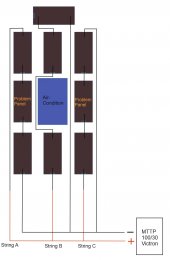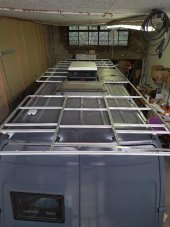Black-on-Plus
New Member
- Joined
- Mar 8, 2020
- Messages
- 5
Hi guys,
I am about to plant a solar system on my van (3S3P - 900W).
the air conditioning is unfortunately a bit higher than planned.
Presumably only 5min/day all panels will get sun at the same time.
It will almost always be one of the two "problem panels" in the partial shade.
Victron says the solar charge controller can handle and compensate for partial shading.
However, I am somewhat skeptical about this statement. Unfortunately I have no practical experience in this
Area. Does anyone have a similar setup? What is your guess when a panel is in the shade?
900W - 100W = 800W or
900W - 300W = 600W ? (of course only theoretical values)
or does someone have a better idea for the interconnection?
I am grateful for every answer!
Panel: 100WP
IMPP: 5.04A
ISK: 5.34
UMPP: 19.86V
UOC: 23.7V
Charge controller: SmartSolar MPPT 100/30 Victron Energy
Load: 24V / 400Ah LiFePo4
I am about to plant a solar system on my van (3S3P - 900W).
the air conditioning is unfortunately a bit higher than planned.
Presumably only 5min/day all panels will get sun at the same time.
It will almost always be one of the two "problem panels" in the partial shade.
Victron says the solar charge controller can handle and compensate for partial shading.
However, I am somewhat skeptical about this statement. Unfortunately I have no practical experience in this
Area. Does anyone have a similar setup? What is your guess when a panel is in the shade?
900W - 100W = 800W or
900W - 300W = 600W ? (of course only theoretical values)
or does someone have a better idea for the interconnection?
I am grateful for every answer!
Panel: 100WP
IMPP: 5.04A
ISK: 5.34
UMPP: 19.86V
UOC: 23.7V
Charge controller: SmartSolar MPPT 100/30 Victron Energy
Load: 24V / 400Ah LiFePo4




